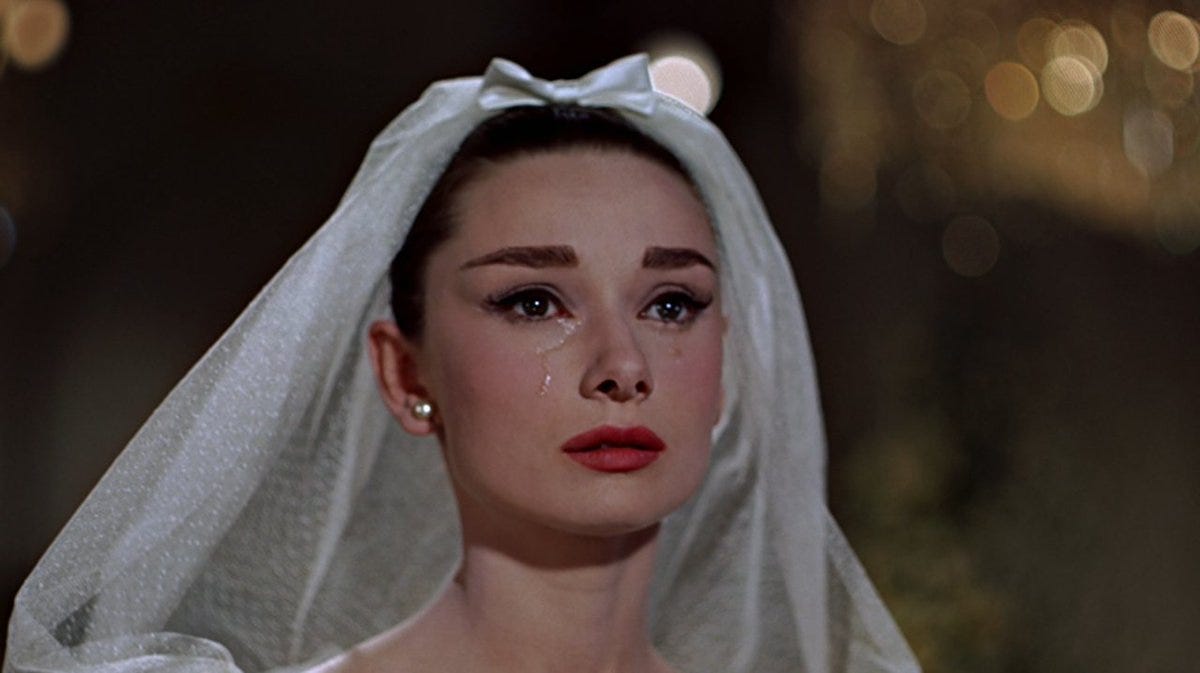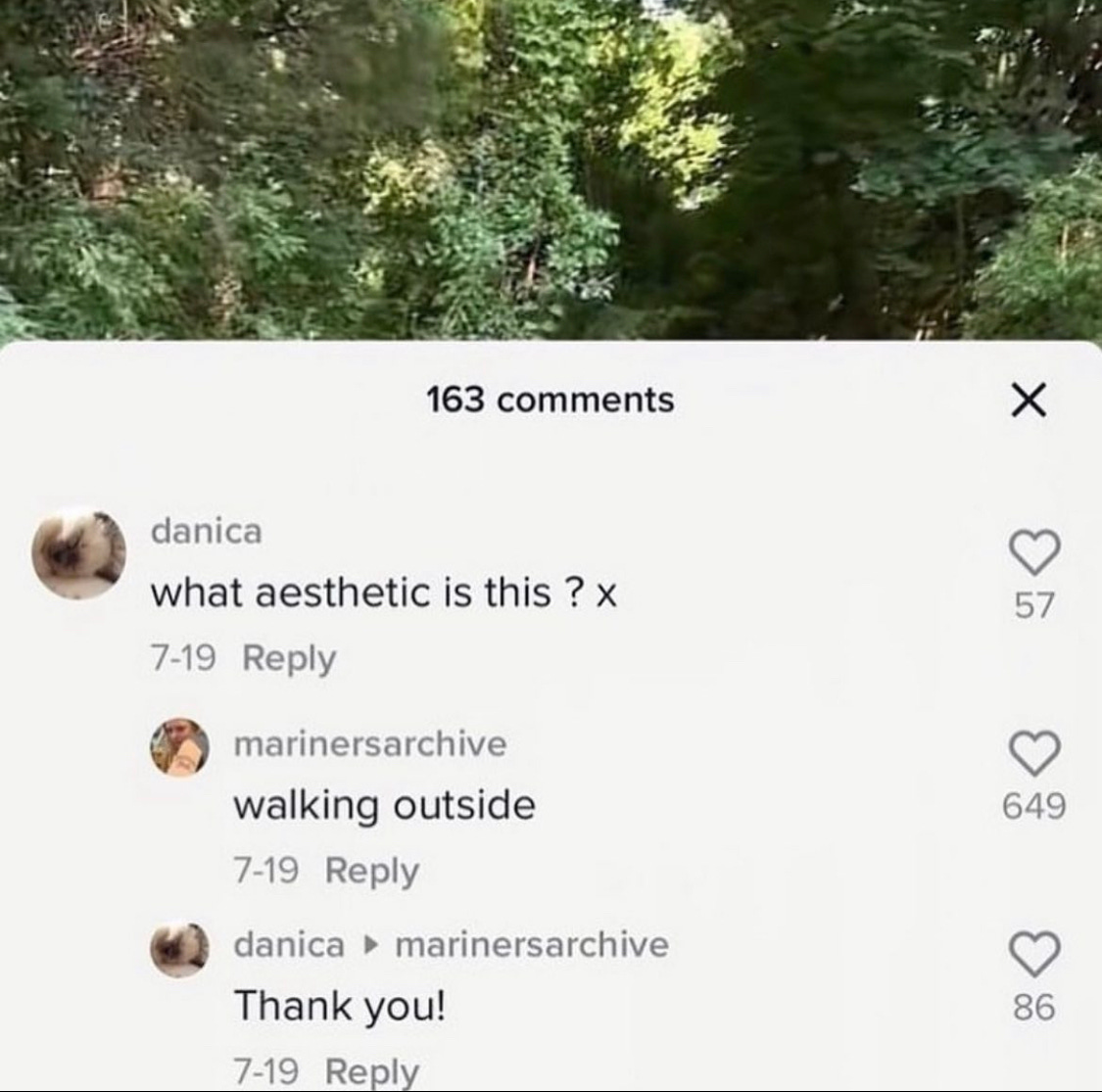Waterproof mascara kept a secure place in my makeup rotation for a reason in high school, particularly while in the throes of AP World History sophomore year. Driving home from school with a freshly issued driver’s license, tears would well up in my eyes to the sounds of SZA as I reflected on my lacking exam results. Quietly singing along to “Love Galore,” noticing the rain on my dashboard paralleling the tears on my face. I would catch sight of my damp eyes in the rearview mirror, eyes puffy, nose red, and eyelashes thick like spider legs. Of all the things I could think of to cheer myself up, the one that did the best job, as I stared at myself crying in the mirror was that I looked…
…kind of pretty?
The rise of TikTok has led to an ascent in niche-Internet aesthetics. Having a self-described “aesthetic” has been an online trend since the days of early 2010s Tumblr blogs; however, the parameters of these new forms of stylistic appearances have become increasingly precise and intertwined with one’s lifestyle.
For example, those with a “cottagecore” aesthetic can be found wearing light cotton dresses and floral bandanas, tending to their home gardens, and making a sourdough starter. Following the “That Girl” aesthetic requires hefty green juice consumption, 6 AM yoga classes, and daily journaling sessions. And when someone’s in their “Fleabag era,” they’re likely donning runny mascara and feeling generally erratic, as the titular character on the television series Fleabag frequently is.
Importantly, if people claiming these aesthetics aren’t actually engaging in these activities, they at least make it look like they are - dressing and behaving like the type of person who would garden, enjoy green juices, or have mental breakdowns. Or people place the type of imagery corresponding with their self-prescribed aesthetic on their cerebral personality mood board, striving to engage in the type of lifestyle and be the type of person that the aesthetic requires.
Like the follow-the-leader nature of the fashion industry, these aesthetics provide style guidance that will change out and reappear at ever-quickening speeds, as Bella Hadid- and Emma Chamberlain-types start exhibiting new characteristics and behaviors that followers can slap an inventive label on and replicate.
The emergence of extensive aesthetic labels and tweets and TikToks of girls claiming they’re in their “________ era” was a noteworthy online development for me to witness, and one remarked about widely online, including in this superb essay by Rayne Fisher-Quann and this video essay by Mina Le. Never before had I seen such enthusiasm for categorizing certain lifestyle choices to fit such detailed online definitions. And why are girls, in particular, flocking to aestheticize themselves and their online appearance?
For one, there is clear comfort in feeling as though one’s interests, hobbies, and aspirations are shared by others. And the Internet provides excellent forums for individuals to reach people outside their physical communities that have similar passions. Yet, men on the Internet do this without proclaiming they’re in their soft girl era - where is the need for romanticization coming from?
Upon self-reflection, I deduced that it likely comes from the same place that makes you stare at yourself in the mirror a little longer as you cry. Look out the window of your bedroom a little more desolately. Wonder what you look like as you read a book in a coffee shop, sipping your latte.
To be a woman is to be watched. To be hyper-aware that even after you’ve shared your thoughts with a person, they may still consider your appearance first and foremost. Letting your ideas exit their brain as quickly as they entered, as they evaluate the way you carry yourself.
Growing up, we learn how to be watched. We witness on-screen leading ladies hail taxi cabs with grace, rest their chins in their hands as they read, hold eye contact as they sip their coffees, and cry long beautiful streaks of tears. And we watch our mothers and our mothers’ mothers model that same artistry that comes with existing as a woman.
We don’t just watch these women though. We also watch men watch women.
In her 1975 essay Visual Pleasure and Narrative Cinema, scholar and filmmaker Laura Mulvey introduces the now famous film concept of the “male gaze.” The “male gaze” refers to how women are historically presented in visual representations, including in films, advertisements, and television programs. The term describes a way of looking at and being seen in the world, that empowers men and sexualizes women. Think of the way numerous women characters are introduced in films, cameras lingering on their bodies, their smizes, them brushing their hair out of their eyes as they arrive at a date, a battle, or as they cascade down a staircase. Coy and demure. Charming and easeful. Alluring. Effortless. In both its optical presentation, and its plot content, women are often presented as accessories and attractive bait to aid a male-driven storyline.
In the words of Margaret Atwood: “You are a woman with a man inside watching a woman. You are your own voyeur.”
Romanticizing our lives as women may just be a byproduct of existing in a world that romanticizes us. Reduces our value to what’s appearance-level. Making such ornaments of us that we can’t help but feel good when we embody an aesthetic.
Instead of just writing, it’s the thought of how we might appear as writers. Not just going to the farmer’s market, the beach, a nightclub, or laying in your bed. But appearing there in a certain way.
Appearing as home gardeners and yoga fanatics. Appearing as mentally stable and mentally unwell, all seen by some audience, even if it’s just an invisible onlooker in our own minds.
And I’d be lying if I said it didn’t feel good. Walking around a farmer’s market in a thrifted floral skirt, adorned with a canvas tote bag and chunky gold jewelry on a bright summer day feels good - and the feeling of it being a page out of a book, a clip from a movie, or a post on an influencer’s profile also feels good. Makes it feel even better. As does the feeling of walking through a city in a lavish silk dress on a night out or staying up late typing away on my laptop with a mug of mint tea in an oversized crewneck. Mentally narrating the scene as if my inner monologue is playing to hundreds in a cinema or via TikTok in a sparkly Day in My Life or GRWM video.
As complex as my feelings about beauty can be, there is a certain comfort, and even sweetness, that comes with viewing life through a rose-colored aesthetic. In post-production, filmmakers tend to bump up the saturation a bit. Add some suitable music to enhance the feeling. Fix the camera on the small things, the rain pebbles on car windows, the hands toying with wine glasses, the feet pushing skateboards. If romanticization fosters a greater appreciation for the beautiful details of life, how bad can it really be? Is the ability to divorce feeling and performance necessary? Achievable?
In college, as I sat at my desk, in the throes of another school subject’s homework, I would often choose to turn the mirror away as I felt the tears threaten to tumble down my face. Try as best as I can to turn off the mental film cameras. See what it was like to “feel” without performing and wonder if that’s even a possibility.
What emerged was often a deep sense of being present. Just staring out the window at the trees, the rain, the mountains, and the dots of lit-up houses, letting the tears fall.
Fighting the thought of how dramatic it must look.




